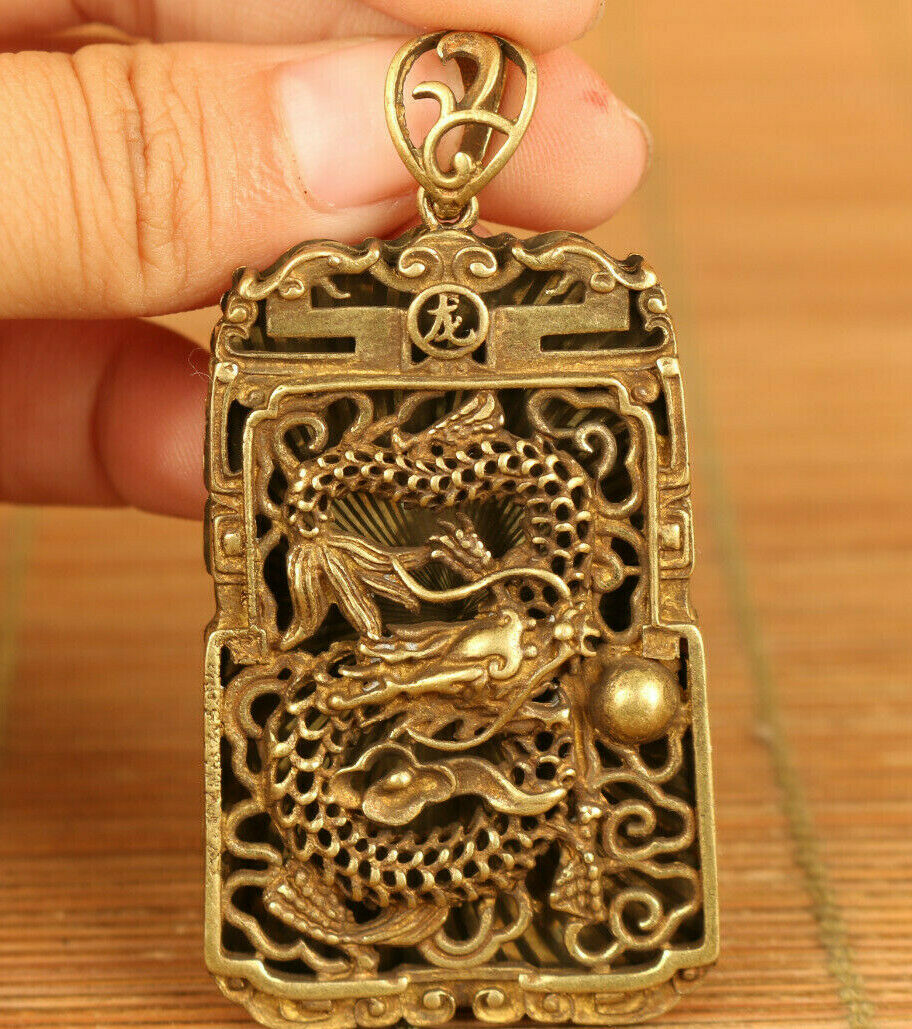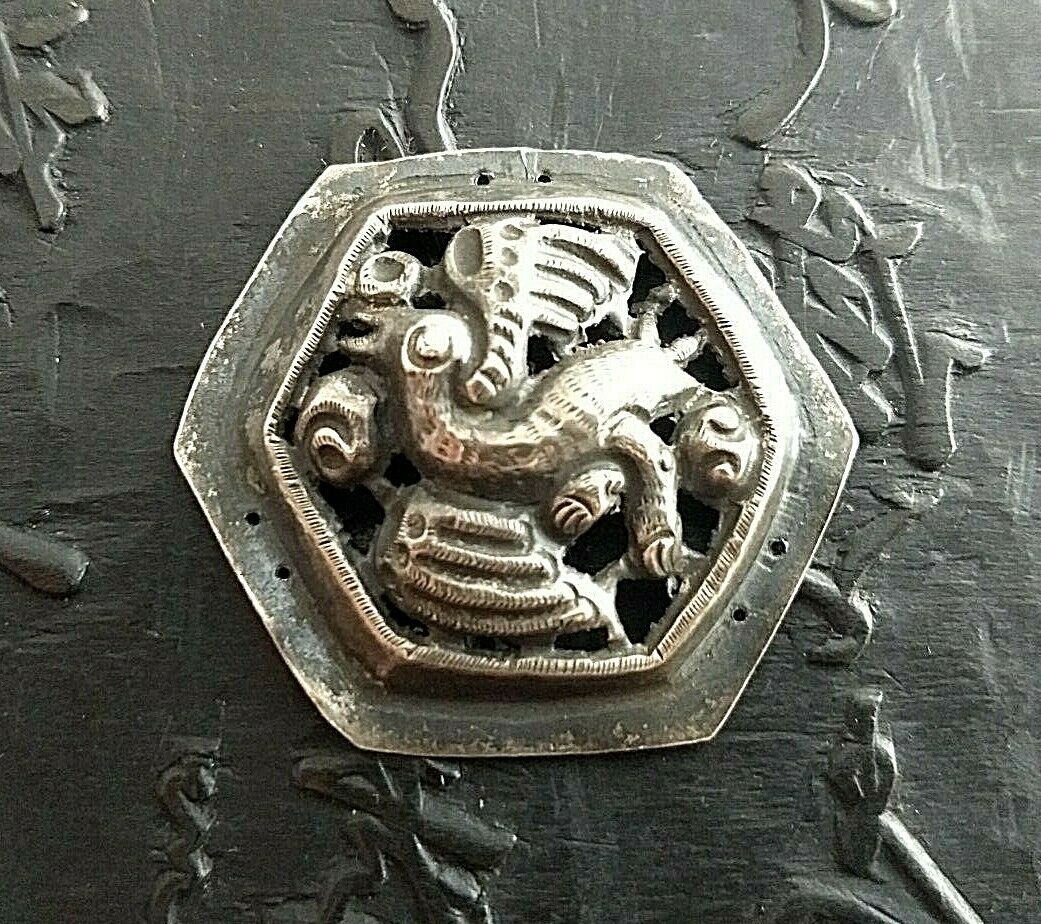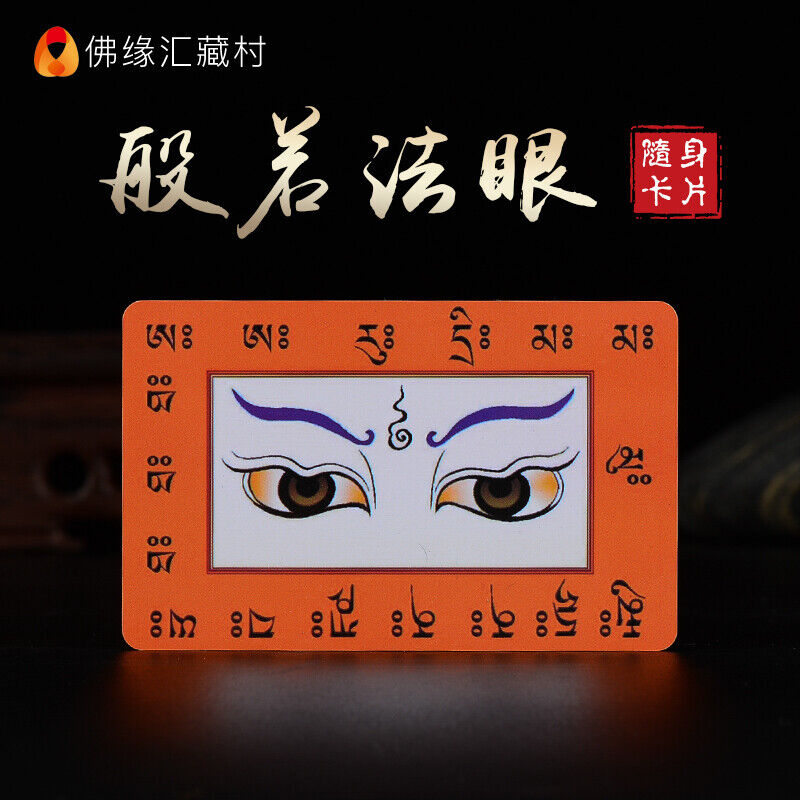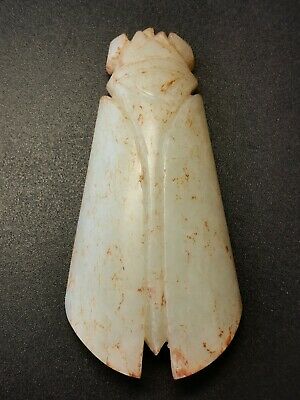-40%
Neolithic Chinese Jade Coiled Pig Dragon “Zhulong” Amulet w/ 75+ Pictographs!
$ 4699.2
- Description
- Size Guide
Description
ANCIENT CIVILIZATIONSArtifacts, Antiques & Fine Collectibles
Ancient Chinese Jade Coiled Pig Dragon “
Zhulong
” Amulet
Est. 75+ Pictographic Character Inscription & English Translation
Hongshan Culture
4500 BCE—2250 BCE
“A Dragon can be unseen or visible, minute or huge,
long or short. However, always it is great.”
~Shuo Wen (c. 100 AD)
NOTE:
William Houghton, the President of ANCIENT CIVILIZATIONS
, a State of Washington Licensed Business, assumes all responsibility for the information contained in this description and for the English translation and transcription of the ancient Chinese graphic characters.
Furthermore, I prohibit the further dissemination of this information in any written, video, or electronic format without my expressed, written approval.
Thank You!
SUMMARY
Item:
Chinese Ritual
Jade Pig Dragon “Zhulong” Amulet
Material:
Highly polished nephrite jade
Culture:
Hongshan Culture
Date:
4500 BC—2250 BC
Measurements:
·
Height:
2.68” (68mm)
·
Width:
1.66” (42mm)
·
Depth:
.82” (21mm)
·
Weight:
3.3 oz. (92gr)
Condition:
This nephrite jade, Hongshan Culture Pig Dragon amulet is in museum quality condition for being about 5,000-years-old.
The celadon green jade has turned an amazing shade of orange/brown from the iron and other elements in the damp soil that have been absorbed into and from the jade after being buried for thousands of years.
This patina should never be removed, because the natural patina is one way to identify an authentic Hongshan jade.
Provenance: This amulet/pendant is one of several items that was obtained from a private collector in China.
I believe these pendants would have been included in an Emperor’s tomb or temple to provide him a safe journey and eternal life in Heaven.
This is the first time it has been offered for sale in the United States.
The
zhulong
(literally, « dragon-pig »), is a magical creature with a body of a pig and the large head of dragon, with two forcefully pricked-up ears, large round eyes, and a flat, wrinkled snout.
It is a hybrid being, the cross between pig and dragon that reflects the imperial power of the Dragon Emperor and the food source of the domesticated pig.
Offerings such as this amulet would have been made in honor of the death of an elite class member of Hongshan society.
Sacrifices of jade, raw meat, ritual wine, and money (in the form of cowrie shells) were made to the Ancestors in Heaven (Tien) so that the departed would have a safe journey to immortal life in Heaven.
Percussively pecked and painted in black paint on all sides of the amulet are incredibly small pictographs that verify that this man/woman was the Emperor or at a minimum held a high-level position in the Emperor’s court or his family, as no ordinary man or woman would have dared to have an Imperial Dragon on a piece of jade that would have been placed in a tomb or in his or her temple. {See details below.}
This 5,000-year-old ritual jade amulet contains an estimated 75+ pictographs and characters that have been incised and percussively pecked into the jade dragon.
These pictographic characters on ritual and tomb jades are the earliest form of a written language in ancient China.
Modern archeologists call these early pictograms oracle bone script as they have been found as a permanent record that was written by scribes on both oracle bones of cattle and on ritual jade artifacts.
NOTE:
Items offered for sale by Ancient Civilizations are unconditionally guaranteed authentic. They were legally imported to the United States years ago and are legal to sell and own under U.S. Statute Title 19, Chapter 14, Code 2611, Convention on Cultural Property.
DETAILS
This lovely jade Pig Dragon dates to the Neolithic Chinese people known as the Hongshan (4500 BC—2250 BC.)
The Hongshan are believed to have been one the first Neolithic people in China to ever use jade in their tombs and temples.
Amulets such as this Pig Dragon one served as a protective amulet against Evil Spirits that could prevent the man’s soul from reaching immortality in Heaven.
The double-crested Dragon is shown with large, round eyes that have exceedingly small pictographic characters painted on them.
On the dragon's right eye, there is the pictograph of the Son of the departed sacrificing an animal with a flint axe in his right hand. The placement of characters on a Dragon’s eyes is common during this Neolithic period and was meant to symbolize his watchful eyes looking with benevolence on the ritual offerings that were being presented to the gods and Ancestors in Heaven (
Tien
in Chinese).
The .33” (8.4mm) hole in the center of the amulet symbolizes Heaven, the immortal home of the Ancestors and the destination of departed souls after death on Earth.
This large hole has been drilled from both sides of the amulet and it is cone shaped on each side—this hole that is classified by the experts as a “bi-conical bore hole.”
On the inner edges of the hole, there are several, tiny characters maybe 2mm long that have been incised and painted with black paint that symbolize the prayers and offerings to the immortals in Heaven.
They are very tiny as they were meant only for the eyes of the immortal ancestors and not for the unworthy eyes of humans. (
See photo # 5-7.)
At the very top of the amulet is a suspension hole that is another much smaller “bi-conical bore hole,” as it also has been drilled from both sides of the pig dragon’s back.
The inside edges of the holes contain micro-crystalline particles that can only form on worked jade that is over 2,000-years-old.
These crystals, which are also evident in the cut lines on the jade dragon, are very fragile and should never be removed as they confirm that this amulet is ancient.
{See macro photo # 3, 6, 9.}
English Translation of Early Chinese Written Words/Characters (Pictographs)
NOTE:
William D. Houghton, the President of ANCIENT CIVILIZATIONS, a State of Washington Licensed Business, assumes all responsibility for the information contained in this description and for the English translation and transcription of the ancient Chinese graphic characters.
Any translation errors are unintentional and strictly mine.
This 5,000-year-old ritual jade amulet contains an estimated 75+ pictographs and characters that have been incised, pecked, and painted with black paint onto the jade pig dragon.
These pictographic characters on ritual and tomb jades are the earliest form of a written language in ancient China.
Modern archeologists call these early pictograms oracle bone script as they have been found as a permanent record that was written by scribes on both oracle bones of cattle and on ritual jade artifacts.
The once, olive-green jade pig dragon and the tiny pictographic characters incised onto it have turned an orange/brown color from the iron, micro-crystalline jade, calcium, and other elements in the damp soil that have been absorbed into the jade after being buried for thousands of years. The shallow incised characters have been differentially eroded on the jade and thus are exceedingly difficult to transcribe and translate.
All the pictographs are ridiculously small, some only 2mm long, that were only meant to be seen by the Ancestors, as human eyes were not worthy. Although the characters are tiny and may look just like random spider webs or blotches of paint, under 10x-20x magnification you can see them.
Here are just a few of the pictographs I’ve translated:
1.
The Sons and Grandsons offering the traditional items of jade, ritual wine, and sacrificed animals to the Ancestors.
2.
On the Dragon's right & left eyes, the Son is shown sacrificing an animal with a flint knife.
3.
Ancestors pictured watching the offerings presented by the Sons and Grandsons.
4. Black painted Dragons on both sides of the tail of the Pig Dragon.
5.
Perhaps 70+ other pictographs, including those on the column between the Dragon’s two crests on his head that are indecipherable.
{
See macro photo # 10-11.}
Ancient Chinese Jade
Jade offerings were highly prized by these early civilizations in China, and were thought to have positive energy to drive away evil spirits and bring good luck and fortune to all who wore a piece on their person—in life and in death.
Jade was also believed to be a portal or messenger that could carry prayers to Heaven and send messages to those on Earth from departed ancestors and Gods in Heaven.
Ancient Chinese jade offerings were always made of green nephrite and not the more modern jadeite.
The amulet displays a lovely .1mm rust-colored patina over its original celadon green color.
In ancient times, jade was particularly difficult to work without metal tools, and had to be polished by means of abrasive powders, grinding and milling, a process that involved intense effort as well as a real expertise and a great deal of time to craft only with primitive hand tools.
As many of you know, Nephrite jade, also known as “soft jade” or “ancient Jade” in China, was used from China’s early Neolithic cultures in 8,000 BC to 1800 AD for carving all types of ritual and utilitarian items.
Nephrite, which is somewhat “softer” than the jadeite used by Neolithic Japanese and European cultures, was easier to cut, carve, polish, and drill than jadeite.
So, the ancient Chinese found that Nephrite Jade could be worked by using quartz or garnet sand, polished with bamboo or jade dust, and even drilled with bone drills that used a slurry made of jade dust and water as the abrasive.
Jade (called the “
Stone of Heaven
” by the Chinese) is priceless. Testifying to how much the Chinese are fond of jade is this time-honored proverb: “
Gold may have a price, but jade is priceless
.” The value of gold can be determined by measuring its weight. Not jade. The value of a piece of jade is “assessed” by taking numerous factors into account. For example, the luster, purity and color, the sound it produces when struck, and when the jade piece was discovered or when and where a jade artifact was produced can affect a piece’s value.
Dragon Symbolism in China
In China, the Dragon (in Chinese “
Long
” or “
Lung
”) has for millennia been the symbol of the Emperor, the Son of Heaven, eternity, Yang and Yin, as well as for male vigor and fertility.
The Dragon is considered as one of the 12 Ornaments and one of the most comp00lex and multi-tiered Chinese symbols. The Chinese dragon can fiercely protect one from Evil Spirits and harm.
This large, jade amulet depicts a mythical Pig Dragon standing on all fours, who was meant to serve as a fierce, protective creature that could fight-off Evil Spirits that could prevent the man’s soul from reaching immortality in Heaven. Dragons are also revered for their ability to transport humans to the celestial realms after death.
In China, the dragon is credited with having great powers that allowed it to make rain and control floods by striking the river with its mighty tail, for example. They are symbols of the natural world, adaptability, and transformation to immortal status. When two dragons are placed together in opposite directions, they symbolize eternity, i.e., the famous Yin-Yang symbol.
Chinese emperors literally thought they were the real dragons and Sons of Heaven. Thus, the beds they slept on are called "dragon beds;" the throne, a "dragon seat;" and the emperor's ceremonial dresses are known as "dragon robes."
In the minds of the early Chinese people, the dragon was a god that embodied the will and ideals of the Chinese people. It is said that the dragon is a large-scaled reptile, which can become dark or bright, large or small, long or short, and fly into the sky in the spring and live underwater in the fall.
It seems that the dragon is capable of doing almost anything.
Traditionally, the dragons were considered the governors of rainfalls in Chinese culture. They had the power to decide where and when it would rain. They also believed kings of water dragons lived in dragon palaces under the ocean. The Chinese sign for the dragon appeared during the Yin and Shang dynasties (16th-11th century BC -- the period of the earliest Chinese hieroglyphs), between inscriptions on bones and turtle shields. The inscriptions depicted a horned reptile, with teeth, scales and sometimes even claws.
In ancient China, nobody had any doubt about the existence of dragons. People showed great respect for any depictions of dragons -- in paintings, carvings, and writings. As a result, the dragon became the symbol of the Chinese nation. All people in China, including the emperor, prostrated themselves before the image of a dragon with reverence and awe. As a result, this fictional creature became the spiritual sustenance for the nation first as the totem of a tribe and then as the symbol of the nation. Eventually, the dragon became the symbol on the national flag of the last feudal dynasty, the Qing Dynasty. The Chinese people considered themselves the descendants of the dragon.
A
s the emblem of the emperor and imperial command, the legend of the Chinese dragon permeates the ancient Chinese civilization and has shaped its culture. Its benevolence signifies greatness, goodness and blessings.
REFERENCES:
·
The Ancestral Landscape
, David N. Knightley, 2000
·
Chinese Characters,
Dr. L. Wieger, S.J.
·
The Great Bronze Age of China
:
An Exhibition from the People’s Republic of China
, edited by Wen Fong, 1980
·
Metropolitan Museum of Art, NYC
·
Ancient Chinese Warfare
, Ralph D. Sawyer, Mei-chün Sawyer
·
Archaeology
, Archaeological Institute of America, Feb/March 2015
·
Shanghai Museum, China
·
Museum of Chinese History, Beijing, China
·
National Palace Museum, Taipei, Taiwan
·
British Museum
·
Smithsonian Museum, Sackler & Freer Gallery, WDC
Please examine the macro photos taken indoors carefully, as they are part of the description.
The stand and AA battery are not part of the auction, just included to give you a better perspective.
And please ask any questions before you buy.
I GUARANTEE this amulet is ancient and authentic or your money back!
Per e-Bay's rules, PayPal only please!
THANKS!
FREE SHIPPING IN USA includes INSURANCE for all 50 United States.
Overseas buyers are responsible for all import & excises taxes, duties, and shipping charges. Thank You!


















